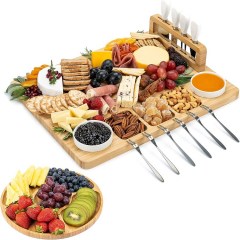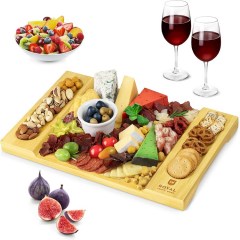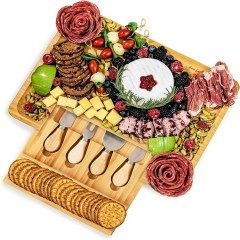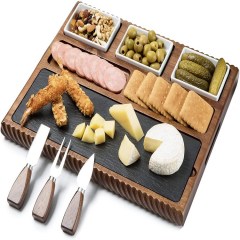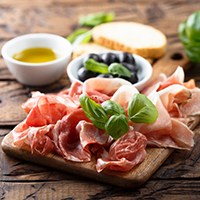Buying guide for best charcuterie boards
When hosting a get-together, it can be difficult to spend time with your guests while still making sure there’s enough food and beverages for everyone. But if you don’t want to spend all your time in the kitchen, a charcuterie board is the perfect solution.
A charcuterie board contains a selection of meats, cheeses, nuts, dried fruits, olives, crackers, bread, and condiments that you can prepare ahead of time and is usually served as an appetizer. It’s easy to customize it with your favorite selections too. To serve a truly impressive spread, you need a high-quality board to place all your goodies on.
When shopping, first decide what material you prefer and the size you need. It’s also important to choose the right shape and figure out if you need any included accessories for preparing or serving the food. Also, consider how easy the board is to maintain to ensure it will last for many years. A shopping guide and product recommendations can help narrow down your options, so you can find the best charcuterie board for your next party.
How to buy the best charcuterie board
What is a charcuterie board?
“Charcuterie” is a French word that refers to cooked, smoked, and cured meats or a shop that sells them. Traditionally, a charcuterie board is a platter of assorted meats. However, when served at home or for parties, the boards generally also include cheeses, nuts, dried and/or fresh fruits and vegetables, olives, jams, spreads, crackers, and breads.
A charcuterie board is usually served at cocktail parties or as an appetizer at dinner parties. It’s often served buffet style, so guests can help themselves throughout the party.
Material
Nearly all charcuterie boards are made of wood. Wood is the material of choice for several reasons, though appearance is a key factor. Wood is also affordable and relatively easy to clean and maintain.
The type of wood is crucial. It shouldn’t be too soft because softwoods can absorb fats and oils from meats, cheeses, nuts, and other foods, causing stains and odors to develop. To ensure your board lasts a long time, avoid charcuterie boards made of cedar, pine, cypress, and other softwoods. Instead, opt for a board made of nonporous hardwood, such as hard maple, birch, teak, olive, or American cherry.
If you prefer an eco-friendly board, bamboo is an ideal option. Bamboo is grass that looks and feels like wood. It grows quickly, reaching maturity in as little as five years. That makes it highly renewable compared to hardwoods, which can take decades to mature.
No matter what type of wood you choose for your charcuterie board, make sure it doesn’t have a varnish or lacquer finish. These coatings usually aren’t food safe and can chip off and make their way into your food.
While wood is the most popular material for these boards, it requires some maintenance, including hand-washing and regular treatment with food-safe oil. As a result, some people prefer a ceramic or porcelain board because it’s easier to clean. However, these materials can crack or shatter if dropped. If you’re concerned about this type of damage, a board made of plastic, such as melamine, is an excellent alternative. It’s easy to clean and won’t shatter if dropped.
Size
A charcuterie board should be large enough to hold enough food for all your guests. Pay careful attention to the dimensions listed in the product description. For small groups of three or four people, a board that measures 9 x 13 inches is usually sufficient. However, for larger groups, you’ll want a board that’s at least 20 inches long.
In some cases, you might want to have two or more smaller boards rather than a single large board. That allows you to separate different types of foods or create boards with different themes. For example, you can separate spicy options from other foods to make sure that no one accidentally eats something that’s too spicy for them.
If anyone at your party is vegan, you can add dairy-free cheeses and meat substitutes to your charcuterie board too.
STAFF
BestReviews
Features to look for in charcuterie boards
Shape
Most charcuterie boards are rectangular, which works well for laying out the selection of foods. You can also find some square boards, though they typically don’t offer as much space as a rectangular board.
Some round charcuterie boards are also available. These are generally more challenging to use because it isn’t as easy to lay out the portions of various foods on a circular shape. Other boards come in unique shapes, such as oblong, oval, or triangle, or novelty shapes like a flower or heart.
Compartments
Some charcuterie boards include built-in compartments to separate the foods. These compartments can hold trays or cups of spreads and jellies or foods like nuts and olives. You can also place the food directly in these compartments to keep them separate.
Sets
Some charcuterie boards come as a set that includes accessories. These can be tools and utensils for preparing and serving the food you’ll use in your spread, such as stainless steel cheese knives and forks. Others might also come with small bowls to hold jams, spreads, and other condiments.
Maintenance
A charcuterie board should be easy to clean, so you don’t have to spend too much time removing stains and bits of food after you use it. Wooden boards aren’t difficult to clean, but they must be hand-washed. Putting a wooden charcuterie board in the dishwasher will damage the wood.
Most ceramic, porcelain and plastic boards are dishwasher safe, making them extremely easy to clean. However, always follow the manufacturer’s instructions to make sure you don’t damage the board.
DID YOU KNOW?
You can put together your charcuterie board ahead of time and refrigerate it. Remove it from the fridge about 30 minutes before guests arrive so the foods are at room temperature and their optimal flavor.
STAFF
BestReviews
How to accessorize a charcuterie board
Cheese knife set
If your charcuterie board doesn’t come with any tools, you’ll need a cheese knife set for cutting and serving the cheese. These sets come with multiple types of knives to cut both hard and soft kinds of cheese. Some also include a cheese spreader and fork.
Cheese slicer
A cheese slicer allows you to cut cheese quickly and efficiently when preparing it for a charcuterie board. You can find handheld cheese slicers and others that are attached to a cutting board.
Ramekins
If you’re adding jams, jellies, dips, and condiments to your charcuterie board, you’ll need a set of ramekins to hold these items. Most charcuterie sets include ramekins that can hold 6 to 8 ounces, and these oven-safe dishes make it easy to warm up sauces or dips.
Cocktail picks
You can make it easy for your guests to help themselves to the food on your charcuterie board with some cocktail picks. Many are disposable and only used once. However, you can also find some reusable metal picks.
How much do charcuterie boards cost?
Inexpensive
The most affordable charcuterie boards cost about $13 to $39. Many of these boards are made of softer woods, so they might stain and develop odors over time. These boards typically don’t come with any or many tools.
Mid-range
These charcuterie boards usually cost $40 to $89. They’re made of hardwoods that won’t easily stain or develop odors. Most come with accessories, such as tools for serving and cups to hold condiments.
Expensive
The most expensive charcuterie boards typically cost $89 to $200. These are made of high-quality hardwoods and can be fairly large. They also include accessories, like tools for serving and cups for condiments.
If you’re having trouble finding room for the crackers on your charcuterie board, consider stacking them vertically rather than spreading them out horizontally.
STAFF
BestReviews
Tips
-
First, add the bowls or ramekins to your charcuterie board. These usually require quite a bit of space, so you want to make sure there’s room for your bowls of olives, pickles, veggies, fruits, jams, spreads, and condiments at the start.
-
Arrange the cheeses and meats. Since these are the stars of the board, you want to make sure there is plenty of space for them. Spread them out, leaving room to scoop or slice the items as necessary. Place the cheese first to make sure there’s enough room, because the meats can often be piled if space is limited.
-
Make room for the crackers and bread. Some people like placing these on smaller trays on the board to separate them from the other foods. However, if you prefer, you can place your bread and crackers directly on the charcuterie board.
-
Fill in empty spaces with nuts and dried fruits. You want the board to look full, and these smaller food items work well to fill any gaps.
-
Finally, garnish the board with fresh herbs. You can add visual interest and color by placing sprigs of your favorite herbs along the board’s edges. They have the bonus of smelling great too.
FAQ
Q. Do I need a special tray to make a charcuterie board?
A. You don’t necessarily need to purchase a dedicated charcuterie board to create these platters of meats, cheeses, and other foods. Instead, you can use any large wooden tray or cutting board you already have.
However, purchasing a dedicated charcuterie board lets you know it has a food-safe finish. If you’re unsure about the finish of your board or tray, you can lay a piece of parchment paper over it and place the food on that.
Q. What meats and cheeses work best on a charcuterie board?
A. You have plenty of options when choosing what to put on your board. Consider meats like Serrano ham, capicola, prosciutto, country ham, speck, salami, mortadella, soppressata, pepperoni, and smoked salmon, but any smoked, cured, or preserved meat makes a tasty option.
When it comes to cheeses, you have many choices, but it’s a good idea to use a mix of textures and flavors. Try soft cheeses like brie, goat cheese, and burrata; semisoft cheeses like fontina and Havarti; firm cheeses like cheddar, gruyere, and gouda; and hard cheeses like asiago, Parmigiano-Reggiano, and Pecorino Romano. They are all delicious choices for a charcuterie board.
Q. Should I add spreads, jellies, or chutneys to a charcuterie board?
A. You’ll want to have at least one condiment on your board. Some options include honey, pepper jelly, fig jam, mustard, sweet chutney, hummus, pesto, and olive tapenade. You can also add a plate of herbed olive oil and balsamic vinegar for dipping.


